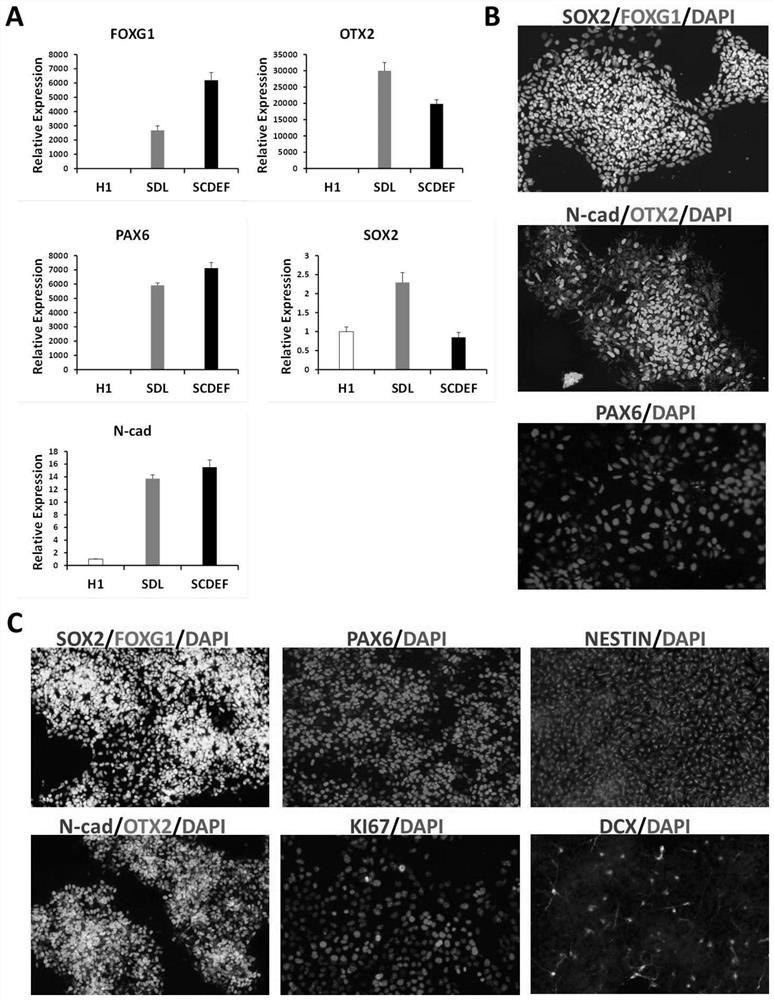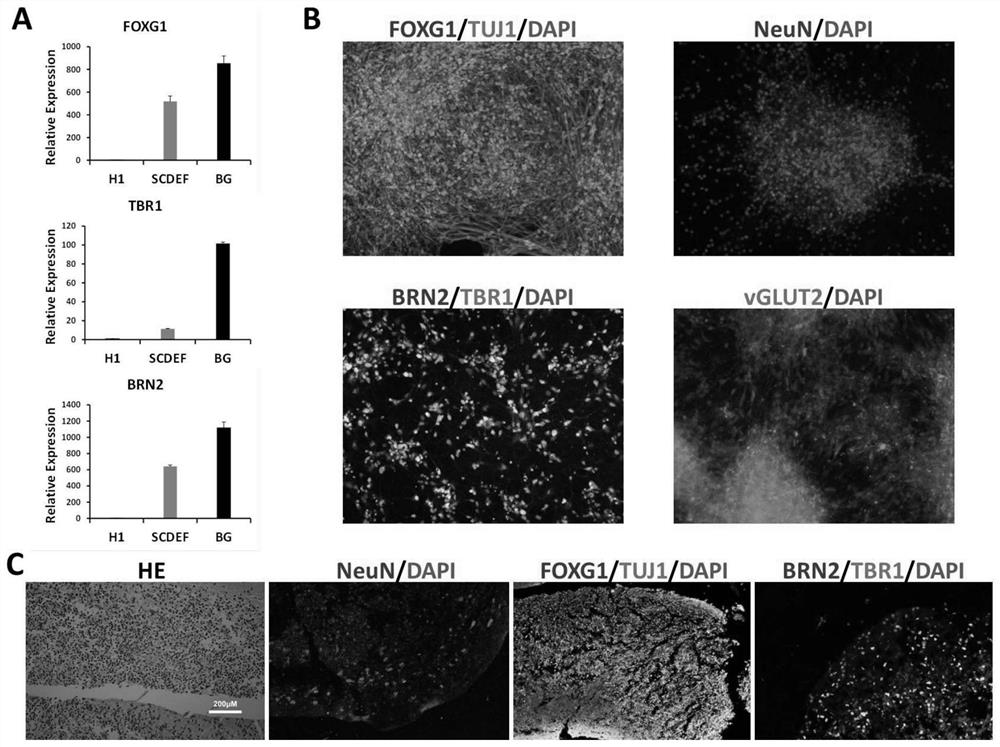In-vitro induction and long-term culture system, induced culture method and application of forebrain neural stem cells
A neural stem cell and culture system technology, applied in the field of biomedical engineering, can solve the problem of inability to maintain forebrain neural stem cells for a long time
- Summary
- Abstract
- Description
- Claims
- Application Information
AI Technical Summary
Problems solved by technology
Method used
Image
Examples
Embodiment 1
[0048] Example 1: Induced acquisition and long-term culture of forebrain neural stem cells in vitro and their molecular phenotype and functional testing
[0049] 1. Acquisition of forebrain neural stem cells
[0050] The surface of the cell culture dish was pre-coated with DMEM / F12 medium containing 1% matrigel (Corning, Cat#356231), and stored at 4°C overnight. Human pluripotent stem cells (H1 cell line) were inoculated at a density of 10%, and cultured in an induction medium of forebrain neural stem cells.
[0051] The optimal composition of the medium is as follows: basal medium DMEM / F12, 0.5×N2 (Thermo Fisher Scientific, Cat#17502048), 0.5×B27 (Thermo Fisher Scientific, Cat#17504044), 60 μg / mL 2-phospho-vitamin C ( Sigma-Aldrich, Cat#A8960), 1% penicillin / streptomycin, and the above medium is named as basal medium or BM. Add 1 μM BMP receptor inhibitor DMH1 (Selleck, S714602), 0.1 μM Porcupine inhibitor LGK974 (Selleck, S714302), 2 μM TGFβ receptor inhibitor SB431542 (Se...
Embodiment 2
[0058] Example 2: Long-term cultured forebrain neural stem cells in vitro can be differentiated into forebrain cortical neurons
[0059] 1. Monolayer differentiation: the surface of the cell culture dish was pre-coated with DMEM / F12 medium containing 1% Matrigel, and stored at 4°C overnight. The long-term cultured forebrain neural stem cells were digested and centrifuged, resuspended with neuron differentiation medium and inoculated on the pre-coated culture support, the medium was replaced every 1-3 days, and cultured for 2 to 3 weeks; neurosphere differentiation: The long-term cultured forebrain neural stem cells were digested and centrifuged, resuspended with neuron differentiation medium and inoculated in a low-adsorption six-well culture plate, the cells converged into balls, the medium was replaced every 1-3 days, and cultured for more than 1 month .
[0060] The optimal composition of the medium is as follows: 1×B27 supplement, 1% penicillin / streptomycin, 60 μg / mL 2-ph...
Embodiment 3
[0063] Example 3: Long-term cultured forebrain neural stem cells in vitro can be applied to transplantation
[0064] The forebrain neural stem cells obtained by the method consistent with Example 1 were cultured in vitro. According to 1*10 5 Forebrain neural stem cells were passaged to a six-well plate, and EGFP lentivirus (Shanghai Heyuan Biotechnology, clone number GL107) was added to the medium after 24 hours, and a blank control group was set at the same time (there was no virus in the medium) After 8-10 hours, replace with virus-free SCDEF medium. After 48 hours, the fluorescence positive rate of the cells was observed under an inverted microscope. Because the virus-transfected cells will have puromycin (puromycin, puro) resistance, puro (Selleck, S741706) was added to select for 2-3 days, and the cells without puro resistance will die. EGFP-labeled cell lines can then be obtained. Digest with TrypLE trypsin (Gibco, Lot: 2152550) at 37°C for 1 minute before transplant...
PUM
 Login to View More
Login to View More Abstract
Description
Claims
Application Information
 Login to View More
Login to View More - R&D
- Intellectual Property
- Life Sciences
- Materials
- Tech Scout
- Unparalleled Data Quality
- Higher Quality Content
- 60% Fewer Hallucinations
Browse by: Latest US Patents, China's latest patents, Technical Efficacy Thesaurus, Application Domain, Technology Topic, Popular Technical Reports.
© 2025 PatSnap. All rights reserved.Legal|Privacy policy|Modern Slavery Act Transparency Statement|Sitemap|About US| Contact US: help@patsnap.com



